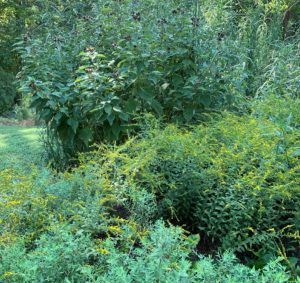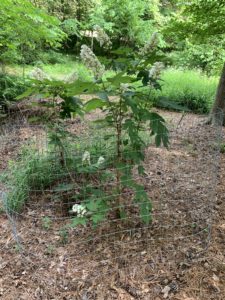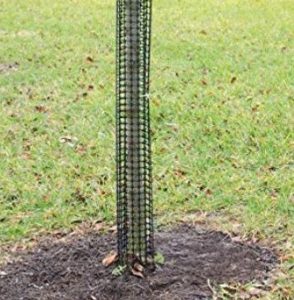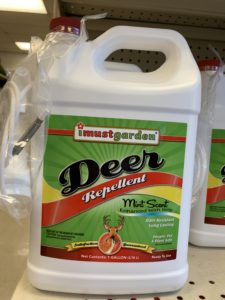Deer Wars
Author: Jim George
It may be a little dramatic to use the term “war” to describe the ongoing battle against the deer in restoring native habitat for birds and pollinators in our yards, but at times, it definitely feels like it. My house is on a 1/3 acre lot in an older suburb of Chapel Hill with closely spaced houses, and there’s a deer herd that passes through my yard on its regular rounds, day and night, browsing on my plants and my neighbors’. My wife and I even have watched a mother deer gave birth in the woods at the back of our lot!
As we take away more and more undeveloped land in this area, the displaced deer population is increasingly taking advantage of our yards for prime places to graze and even reproduce. Unfortunately, they much prefer our native plants and leave our invasive plants untouched. We long ago took away deer’s natural predators, so there is no system of checks and balances. You’ve probably seen the dramatic video of the return of nature when wolves were reintroduced in Yellowstone National Park causing a “trophic cascade.” However, I doubt that there will be much support for re-introducing wolves in the Piedmont! Of course, there is the culling of deer populations through hunting and certainly that helps some, but it is not very practical or safe to hunt the deer that are hanging out all day and night in suburban yards. Plus, it doesn’t take many deer at all to decimate the native plants in your yard.
This article will focus on the practical measures that homeowners can take to try to gain the upper hand against the deer. As in any war, there will be several battle fronts and inevitably some losses, but the losses can be reduced to more tolerable levels to tilt the battles in favor of the homeowner.
 Goldenrod is deer resistant and a keystone plant for birds.
Goldenrod is deer resistant and a keystone plant for birds. - Grow deer resistant native plant species
Last year I planted a swamp milkweed to replace one carried away in street flooding at my house. I didn’t protect it because it’s poisonous and supposedly avoided by deer. I came out one morning to find a deer had eaten it. After a few choice words that are unprintable, my hope was that that deer at least had a bad belly ache. I am telling this story to let you know that no plant is deer proof, especially when the plant is small. Deer like to sample plants. This sampling is tolerable on larger, mature plants, but can be a disfiguring or even fatal problem for new sprouts or new additions to your garden. Even deer resistant plants may need occasional protection from one of the methods listed below, but in general they are much less likely to be browsed. Deer resistance is labeled on New Hope Audubon’s recommended native plants for the Piedmont. This approach has one major drawback since it does not allow for biodiversity. A yard full of just deer resistant plants like spicebush or mountain mint lacks the biodiversity needed to fully support wildlife.
- Put up fences around sections of your yard
Fencing is the only foolproof method of protecting major sections of yards. However, deer can easily jump lower fences, and most people don’t want the look of higher fencing in their front yards, so it’s usually reserved for back yards. Fences that deer can see through have to be at least 8 feet high to keep deer from jumping over, but solid fencing that they can’t see through can be somewhat lower. Fences do not have to be highly visible or detracting as shown on the attached photo. For more information, see this discussion of deer fences. Certain types of high fencing may be prohibited by some HOAs so you may need to work this out with them first.
- Use cages around tree saplings and shrubs
Wire cages can be used around tree saplings and shrubs until they get high enough that the deer won’t browse them. The deer browse line is up to 6 feet, so once the foliage is mainly above that level, the caging can be removed. However, a young tree may continue to need “buck-rub” protection, which is covered in the next section. I’ve use old rusty tomato cages of the cylindrical, make-your-own style for cages for the youngest plants, and they are barely visible. Four foot galvanized wire fencing makes a sturdy cage as the tree or shrub grows and can be cut to any size needed. I’ve included a photo of an oak leaf hydrangea that could not develop because of deer browse until I put a cage around it. All cages need to be pinned down around the sides or held in place with long stakes to keep them from being pushed aside by the deer.
- Protect trunks from buck rub
Bucks will rub their antlers against tree bark to remove the “velvet” off the new growth of their antlers and thus smooth them and reduce itching. This rubbing can strip away the bark and the cambium layer between the bark and the outer wood that is vital for moving nutrients back and forth between the tree roots and the leaves. If enough of this layer is stripped off, and especially if it is stripped on all sides effectively girdling the tree, the tree will die. This is a special problem for younger trees, and they will need protection until the trunk is at least sufficiently large in diameter, perhaps up to 4” or more in diameter.
Ben Skelton, owner of Skelton’s Landscaping Service and a native plant expert with the New Hope Audubon Bird Friendly Habitat Certification team, shared the following with me. “I wouldn’t recommend wrapping the trunks in burlap or anything else. That can quickly cause fungal problems and insect problems hiding under the shade and moisture. The best buck rub protection is to use is a plastic mesh tree guard. Also, to protect from buck rubbing, I’ve used rebar pounded into the ground around the trunk. I’ve used 6′ tall pieces of rebar, pounded into the ground about 1′ or so until they feel solid. I put 3-4 evenly around the trunk, about 3-4 inches away from the trunk. This will catch the buck’s antlers and either deter him or limit the damage to the tree trunk. This will last a long time, won’t hurt to leave in the ground for years, and won’t hurt the tree in any near term.”
- Spray plants with a repellent
For perennials that aren’t deer resistant and for newly emerged perennials in the spring that may be sampled, you can spray your plants with one of a number of commercially available repellents. I use a commercial product made locally in Chapel Hill that has a minty smell and has been effective for me. Rain will eventually wash away the repellent, but it should last through a few rains depending on brand. I generally only have to apply it every couple of weeks or so in spring and even less as the summer wears on. I don’t spray unless it is something newly planted or there is evidence of browse, and I try to just spray foliage and not the flowers so I don’t deter or harm pollinators. It is especially important to apply to new plant growth in the spring when browsing can cause the most harm. The deer in my yard leave some plants alone when they get older perhaps because they are no longer sampling everything or there has been some change in the leaves that make them less palatable.
 8 foot deer fencing with deer looking in!
8 foot deer fencing with deer looking in!  Oak leaf hydrangea with wire cage.
Oak leaf hydrangea with wire cage.  Mesh style tree guard that Ben recommends.
Mesh style tree guard that Ben recommends.  Minty-smelling spray that I use.
Minty-smelling spray that I use. The best strategy will be to use some combination of the above methods to wage a multi-front and effective war. Don’t be discouraged by losing some battles. Rather learn from them what is effective and what is not.
“At our house, we call the day we remove a deer cage for good ‘Graduation Day,’ and it is always a celebrated event.” (Doug Tallamy, Bringing Nature Home)
« Back to All Press